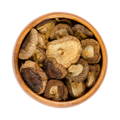Shiitake

Latin Name
Total Polysaccharides %
Beta Glucans %
Starch
Mycilium or Fruiting Bodies?
Substrate
Extract Ratio
Sustainably Grown
Amount per Serving
What is Shiitake Mushroom ?
Shiitake mushroom is the most known edible mushroom globally. In ancient Chinese medicine theory, Shiitake mushrooms were advised for longevity and improving overall health. They said it maintains health, muscle strengthening and circulation, cures colds and helps with reducing blood cholesterol. Shiitake mushroom is commonly grown on the Shi tree (Castanopsis cuspidata Thunb.) or wood logs in Japan, which is the largest producer, responsible for about 83% of global supply, and now various farms in the USA, Taiwan, Canada, and Singapore are producing shiitake mushrooms [1]. It contains carbohydrates, proteins, and necessary amino acids. Shiitake is observed to have a high percentage of polyunsaturated fatty acids and sufficient amounts of vitamins C, B1, B2, B12, niacin, and vitamin D (the greatest concentrations of vitamin D is found in Shiitake more than any plant food). Over and above that, proteins in Shiitake are made up of 18 different kinds of amino acids, including all of the necessary amino acids in proportions that are close to those found in the human diet [2]. Shiitake was investigated as a potential treatment in metabolic syndrome, prevention of cancer, antimicrobial properties and recently as an significant treatment for dermatitis because of its nutritional value and pharmacological activities.
